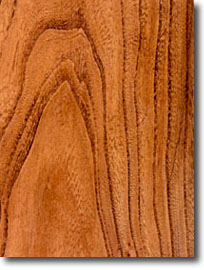 Northern Elm (Ulmus L.) is the most common furniture-making wood found throughout northern China. It is referred to throughout the catalogue as Northern Elm to differentiate it from the somewhat similar appearing Zelkova, which is also commonly called elm, or Southern Elm.
Northern Elm (Ulmus L.) is the most common furniture-making wood found throughout northern China. It is referred to throughout the catalogue as Northern Elm to differentiate it from the somewhat similar appearing Zelkova, which is also commonly called elm, or Southern Elm.
There are over twenty varieties of elm which are widely distributed tree throughout China, but more highly concentrated in the northern regions. Northern varieties noted for producing furniture-making timber include the Japanese Elm (chunyu (U. davidiana var. japonica)), which reaches 30 meters in height and 1 meter in diameter, and the somewhat smaller Manchurian Elm (lieye yu (U. laciniata)). These, along with the more broadly distributed Siberian Elm (bai yu (U. pumila)) all share similar characteristics.
The sapwood of Northern Elm is yellowish-brown; the heartwood, a slight chestnut brown. The wood is difficult to dry and easily develops cracks. The material is of medium density (.59-.64 g/cm3) and hardness, and with the exception of Siberian elm, has relatively low strength. The material is somewhat resistant to decay and easy to work. Because the wood is ring porous, with a wave-like patterning in the growth rings of the late wood, the tangential surface often reveals a layered, feather-like figure that is popular for furniture-making.
Chinese Elm (lang yu (U. parviflora)) is more concentrated in the southern tropical regions, but is also found throughout Shaanxi, Shanxi, Hebei. Its coffee-colored heartwood may also relate to the furniture-making wood popularly called Purple Elm (ziyu). This timber is also difficult to dry, easy to warp and split, but considerably denser (±.90 g/cm3) and harder than the other varieties. It has high structural strength, but the grain patterning is not as striking as Japanese Elm or Siberian Elm; it is also more difficult to work.
Extract from:
Evarts, Curtis. C. L. Ma Collection: Traditional Furniture from the Greater Shanxi Region, 1999.
